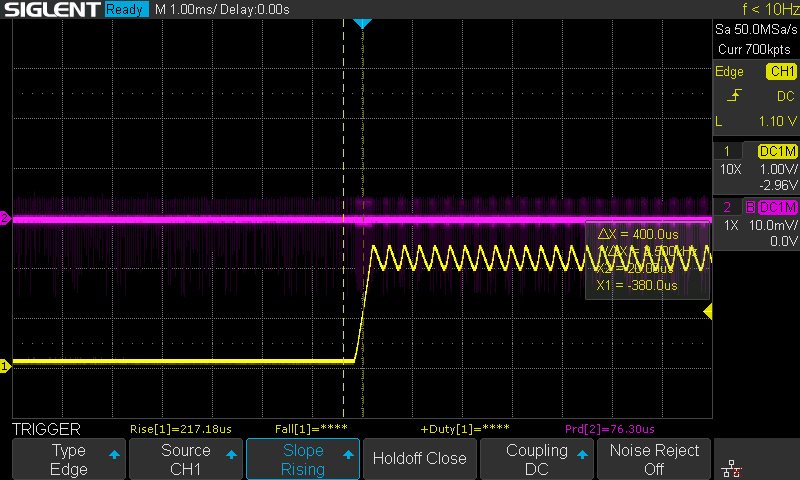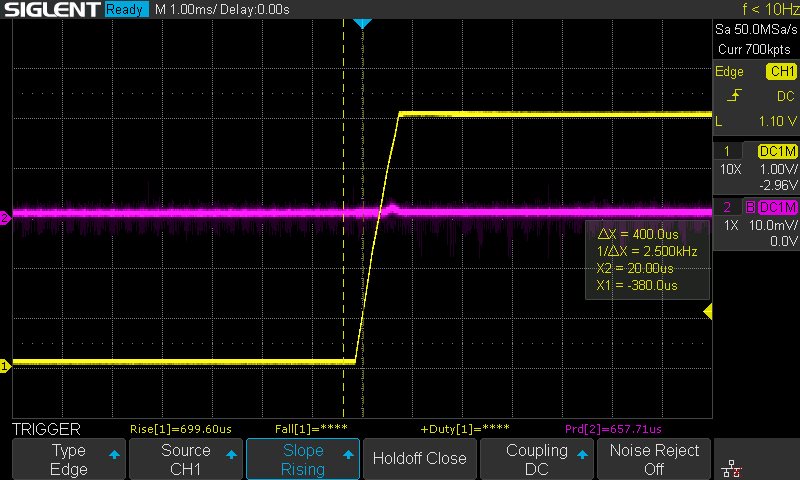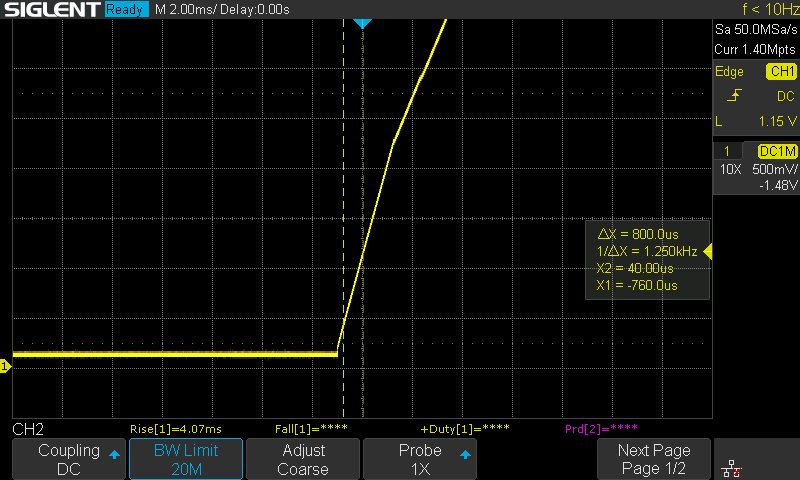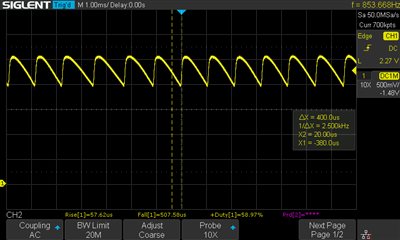Other Parts Discussed in Thread: BQ28Z610,
I have exactly the same problem as this other thread which is now locked. Was this problem ever solved?
One board shows the problem so far, others work fine. Battery pack has bq28z610 and can be turned on by power supply or another good board of mine. But on the bad board, the BQ25792 won't deliver any current to the pack to raise the voltage above 2V. Charger stuck in trickle charge mode, no faults, no current to battery (measured between charger and battery). Otherwise, this charger works fine when the battery voltage is normal.
I can wake a sleeping battery with a 1K resistor to 6V. But when connected to the charger and touching the 1K, the voltage is clamped at 2V and the battery won't wake. Changing to 100 ohms, the external supply is able to wake the battery even when the charger is connected.
Register dump when not working:
VSYSMIN 00: 7000 VINDPM 05: 3600 PCHG 08:01
VREG 01: 8400 IINDPM 06: 3300 TERM 09:05
ICHG 03: 4200 VOTG 0B: 2800 RCHG 0A:63
IOTG 0D:03 TIMR 0E:3D
ChgCtl 0 0F:82 ChgSts 0 1B:0F TEMP 16:C0
1 10:00 1 1C:10 NTC0 17:7A
2 11:00 2 1D:00 NTC1 18:00
3 12:00 3 1E:10 ICO 19:01
4 13:29 4 1F:11
5 14:1C
FltSts 0 20:00 FltFlg 0 26:00 FltMsk 0 2C:00
1 21:00 1 27:00 1 2D:00
ChgFlg 0 22:00 ChgMsk 0 28:00
1 23:00 1 29:00 AdcCtl 2E:B8
2 24:00 2 2A:00 AdcDis 2F:00
3 25:00 3 2B:00 AdcDis 30:00
IBUS 31: 16 IBAT 33: 0 TS 3F: 0
VBUS 35: 11964 VBAT 3B: 112 TDIE 41: 41
VAC1 37: 11912 VSYS 3D: 7347 D+ 43: 0
VAC2 39: 11897 D- 45: 0
DPDM 47:00 Part 48:08 0 err
And from identical circuit on a good board:
VSYSMIN 00: 7000 VINDPM 05: 4800 PCHG 08:01
VREG 01: 8400 IINDPM 06: 3300 TERM 09:05
ICHG 03: 4200 VOTG 0B: 2800 RCHG 0A:63
IOTG 0D:03 TIMR 0E:3D
ChgCtl 0 0F:A2 ChgSts 0 1B:0F TEMP 16:C0
1 10:00 1 1C:70 NTC0 17:7A
2 11:00 2 1D:01 NTC1 18:01
3 12:00 3 1E:00 ICO 19:01
4 13:29 4 1F:00
5 14:1C
FltSts 0 20:00 FltFlg 0 26:00 FltMsk 0 2C:00
1 21:00 1 27:00 1 2D:00
ChgFlg 0 22:00 ChgMsk 0 28:00
1 23:00 1 29:00 AdcCtl 2E:B8
2 24:00 2 2A:00 AdcDis 2F:00
3 25:00 3 2B:00 AdcDis 30:00
IBUS 31: 2720 IBAT 33: 4245 TS 3F: 0
VBUS 35: 12063 VBAT 3B: 7310 TDIE 41: 85
VAC1 37: 12019 VSYS 3D: 7367 D+ 43: 90
VAC2 39: 12021 D- 45: 116
DPDM 47:00 Part 48:08 0 err
Before enabling charge to wake the battery, both good and bad chargers show the same register data:
VSYSMIN 00: 7000 VINDPM 05: 11200 PCHG 08:01
VREG 01: 8400 IINDPM 06: 3300 TERM 09:05
ICHG 03: 4200 VOTG 0B: 2800 RCHG 0A:63
IOTG 0D:03 TIMR 0E:3D
ChgCtl 0 0F:82 ChgSts 0 1B:0F TEMP 16:C0
1 10:00 1 1C:07 NTC0 17:7A
2 11:00 2 1D:00 NTC1 18:00
3 12:00 3 1E:10 ICO 19:01
4 13:29 4 1F:11
5 14:1C
FltSts 0 20:00 FltFlg 0 26:00 FltMsk 0 2C:00
1 21:00 1 27:00 1 2D:00
ChgFlg 0 22:00 ChgMsk 0 28:00
1 23:00 1 29:00 AdcCtl 2E:B8
2 24:00 2 2A:00 AdcDis 2F:00
3 25:00 3 2B:00 AdcDis 30:00
IBUS 31: 3 IBAT 33: 0 TS 3F: 0
VBUS 35: 12484 VBAT 3B: 110 TDIE 41: 36
VAC1 37: 12460 VSYS 3D: 7315 D+ 43: 0
VAC2 39: 12454 D- 45: 0
DPDM 47:00 Part 48:08 0 err









